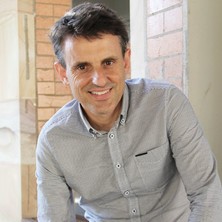2016 UQ Architecture Series with Antony Moulis
By Anita Lewis | 20 January 2016

Hands up, who loves a good architecture talk? We know we do and APDL is pleased to host the UQ Architecture Lecture series which kicks off in early March.
Antony Moulis, Associate Professor and Director of Research in the School of Architecture at the University of Queensland, is part of the team who is coordinating the UQ Architecture Lectures - the first two talks in the eight-week program will also be part of the inaugural Asia Pacific Architecture Forum (APAF).
"This year the UQ School of Architecture is very excited to present two lectures of the series as part of APAF. The forum provides a timely opportunity to highlight work emerging from the Asia Pacific and reveal the networks that Australian architectural practices are building in the region. It’s important to be part of a conversation about regional connections as it can help create a productive dialogue about Queensland architecture in a much bigger context." - Antony Moulis
Today, we learn more about Antony and get a snippet of what's to come from this year's series.
Tell us a little about your background, and what originally led you to architecture?
Travels around the world opened my curiosity to architecture even before I was studying it. I was hooked from the moment I saw the Centre Pompidou in Paris, a controversial building of the time. It’s then that I decided to undertake my architectural studies.
Can you give us a little insight into what a normal work day looks like for you?
Working at University is constantly stimulating in that every day is different from the previous one. At UQ, I get the opportunity to travel to archives and conferences overseas, teach to students with diverse backgrounds and conduct innovative research in collaboration with colleagues in Australia and abroad.
What are some daily office rituals or habits you employ to enhance your productivity and creativity?
Meeting students is an amazing creative resource. Seeing what they design in the studio can really help me think productively and creatively too – it’s a two-way street.
What principles inform your work?
Finding a way through the limited means of making to the unlimited possibilities of architecture – it’s a discipline that is exacting and freeing at the same time.
Where do you go for design inspiration?
I love Paris, there is much to admire of the city’s architectural past but it has also remained a place that fosters great contemporary architecture - it’s a really inspiring way to conceive a city. I visited Frank Gehry’s Louis Vuitton Foundation there soon after its opening in 2014. It’s a building that has come in for criticism of its vast scale, but I was intrigued by the space between the glass shells and its roof terraces – an amazing place to view the city and glimpse new architectural possibilities.
What has been a career highlight for you so far?
My research of the Swiss-French modernist architect Le Corbusier led me to the discovery of a 1960 tapestry he designed and made for the interior of Jorn Utzon’s Sydney Opera House. It was recently purchased by the Sydney Opera House Trust at auction and will be publically displayed in the building this year. It’s a significant cultural asset for Sydney and the nation and it was a real thrill to uncover it, a hidden part of the Opera House’s history.
Which Australian or international architecture people, practices, designers or similar do you admire?
The Japanese architect Sou Fujimoto has created some of the most striking images of contemporary architecture. I had the opportunity to visit his 2013 Serpentine Pavilion in London’s Hyde Park and it was an exemplary work, engaging for the public, and took a form so novel it defied categorisation. Herzog & De Meuron’s Caixa Forum in Madrid is another example of a finely made building that is familiar and yet unfamiliar at the same time. In Australia, Bennett and Trimble in Sydney have developed a diverse and imaginative body of work and in Brisbane A-CH (Atelier Chen Hung) will be a practice to look out for in the future.
What are your top 5 favourite design books?
Operative Design: A Catalog of Spatial Verbs by Anthony di Mari, Nora Yoo
Le Corbusier: Houses by Le Corbusier
The Harvard Design School Guide to Shopping / Harvard Design School Project on the City 2 by Chuihua Judy Chung, Jeffrey Inaba, Rem Koolhaas, Sze Tsung Leong
Sou Fujimoto Architecture Works 1995-2015 by Sou Fujimoto
Nek Chand's Outsider Art: The Rock Garden of Chandigarh by Lucienne Piery, John Maizels, Philippe Lespinasse
What can attendees to the UQ Architecture Lecture Series expect to hear and see?
A diversity of perspectives on architecture as well as discussion of the situations architects find themselves in culturally, socially and politically as they realise their work. There are some really exceptional architects in this year’s series so expect some surprises! I’m really keen to meet this year’s speakers because they are all doing things beyond the everyday of architectural practice. It might seem like an easy thing to do but actually there is so much to admire in those who can inspire others and create something genuinely new. I’m ready to enjoy that – I hope our audiences are too!
Every Tuesday from 1 Mar until 26 Apr (excl. 29 Mar)
6pm for 6.30pm start
SLQ Auditorium 1, level 2 | Free
Booking details released soon.
and
Program of APAF events here
Comments
Your email address will not be published.
We welcome relevant, respectful comments.